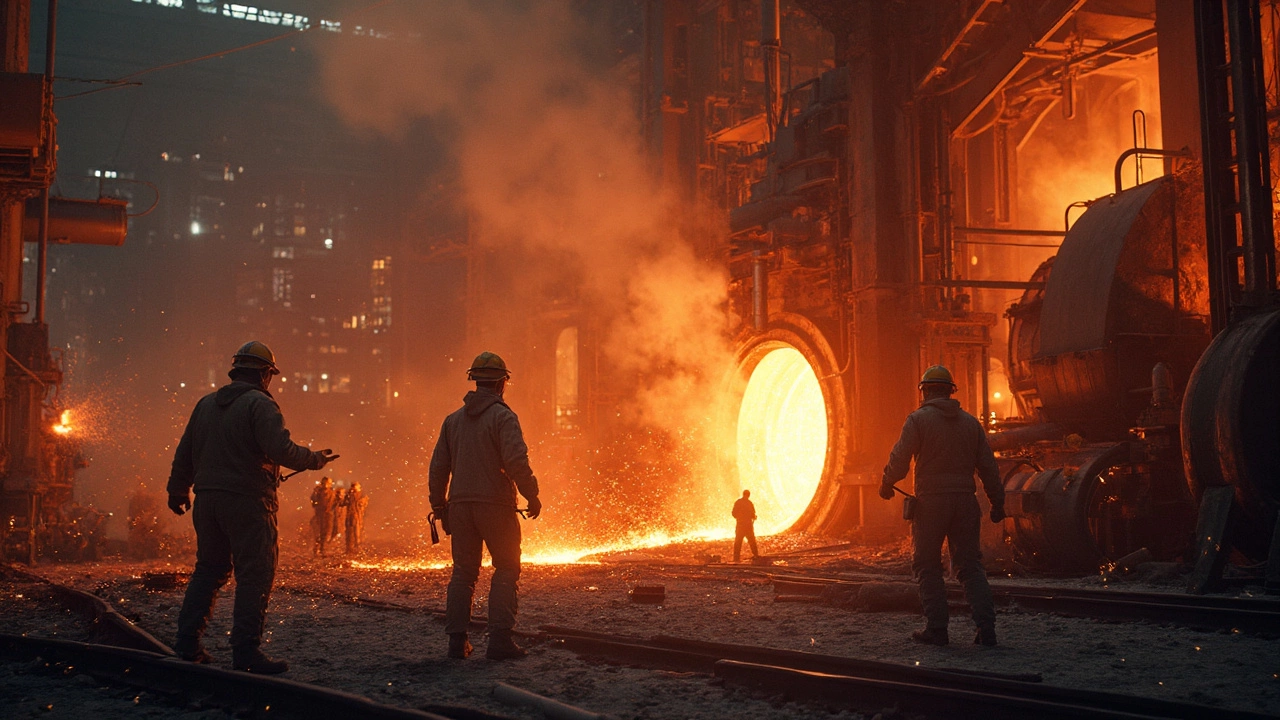You might be wondering if the US still makes steel or if it's completely outsourced by now. Let's clear that up right away. Yes, the US does produce steel, and it's still a significant player in the industry. But, as with many things, it's not as straightforward as it sounds.
American steel manufacturing has a long and storied history. The industry has evolved from the days of Andrew Carnegie and the booming steel mills to today's high-tech facilities. These modern plants focus on both efficiency and environmental sustainability, all while trying to stay competitive on the global stage.
Today, US steel plants, scattered across places like Pennsylvania, Ohio, and Indiana, play a crucial role in local economies. They provide jobs, support secondary industries, and contribute to technological advancements in manufacturing. You can find American steel in anything from towering skyscrapers to the cars we drive. But what really makes the current scene interesting is how these plants are adapting to new challenges.
- A Brief History of US Steel Industry
- Current State of US Steel Manufacturing
- Challenges and Opportunities
- The Future of Steel in America
A Brief History of US Steel Industry
The journey of the US steel industry is nothing short of legendary. It all kicked off in the late 19th century, when Andrew Carnegie turned Pittsburgh into a steel powerhouse. His innovations in steel production drastically reduced costs and paved the way for mass production, fueling America's rise as an industrial nation.
By the early 20th century, the United States had become the largest producer of steel globally. This era saw the creation of some legendary companies like U.S. Steel, which was the world's first billion-dollar corporation. The steel industry was literally building America, crafting railways, bridges, and skyscrapers that changed the skyline forever.
The Decline and Resurgence
However, it wasn't always smooth sailing. The mid-20th century brought new challenges. Global competition, rising production costs, and labor issues led to a decline in American steel manufacturing. By the late 20th century, foreign competition, especially from Japan and Europe, forced many US steel plants to shut down or restructure.
But don’t count the US steel industry out. The late 20th and early 21st centuries saw a resurgence. Modernized plants, technological advances, and a focus on specialty steel products have helped American steel bounce back. The use of electric arc furnaces, for instance, is a game-changer, allowing for more efficient recycling of scrap metal into new steel products.
| Year | US Steel Production (Million Tons) |
|---|---|
| 1900 | 10 |
| 1970 | 131 |
| 2020 | 87 |
While the industry may not dominate like it once did, it remains a vital part of the economy, continuously adapting to meet modern demands. So, the next time you drive over a bridge or gaze up at a shiny new building, remember that it's likely got some good old American steel in it.
Current State of US Steel Manufacturing
So, where exactly does the US stand when it comes to steel manufacturing today? Well, while things are not as booming as they were in the early 20th century, there's still a lot going on. The American steel industry produces around 87 million tons of steel annually, securing its place as one of the top producers globally.
The rise of mini-mills has been a game-changer. You might be asking, what's a mini-mill? Unlike the old behemoth steel mills, mini-mills are smaller, more flexible, and highly efficient. They recycle scrap steel using electric arc furnaces (EAFs), making the process more energy-efficient and environmentally friendly. In fact, over 70% of U.S. steel production now comes from these mini-mills.
Places like Indiana and Pennsylvania are still powerhouses in steel production, but states like Alabama and Arkansas have emerged with new facilities too. Nucor and Steel Dynamics, for example, have expanded operations, staying ahead with innovation and sustainability.
However, the industry isn't without its challenges. Global competition from countries like China, which can produce steel at a lower cost, has forced US manufacturers to rethink strategies. Tariffs imposed on imported steel have been a controversial move, aiming to protect domestic producers but also impacting prices for consumers.
Focus on Innovation
A bright spot in all this is the push for innovation. Technologies like artificial intelligence and advanced robotics are finding their way into production lines, optimizing efficiencies and improving product quality. The adoption of sustainable practices, such as using renewable energy sources and reducing emissions, is gaining traction. The industry's commitment to sustainability can be seen in recent efforts to lower the carbon footprint of steel production.
Overall, while the battle is tough, US steel manufacturing remains resilient and continues to adapt in the face of evolving demands and challenges.

Challenges and Opportunities
So, what's the deal with the US steel production scene today? It's not without its hurdles, that's for sure. It's caught in a bit of a squeeze between global competition and domestic policy shifts. But hey, let's start with the challenges.
Challenges Facing US Steel
The biggie here is cheap imports from places like China and India. These countries can produce steel at a fraction of the cost, making it tough for local plants to keep up. You might've heard of things like anti-dumping duties—basically taxes on imports sold below fair value—to try to level the playing field. But it's not always enough.
Then there's the environmental regulations. Don't get me wrong, going green is important, but the costs of complying can be pretty steep for American steel plants. Modernizing facilities to meet those standards needs big investment, which can be a tough ask for some companies.
Opportunities to Shine
It's not all doom and gloom though. There's a silver lining! The push for sustainability has its perks. Eco-friendly steel production methods can actually open up new markets and lead to innovative tech advances. Being a pioneer in green steel tech could set the US apart and bring big returns.
Plus, there's a growing demand for domestic manufacturing. With a focus on producing goods locally, US steel plants might find fresh opportunities, especially in industries where quality and standards are significant selling points.
- Investing in automation and AI can boost efficiency. Smart tech is making a splash, helping to cut costs and improve output quality.
- Infrastructure projects: The government often rolls out huge infrastructure bills. These need a ton of steel, and that's a chance for local plants to cash in.
So, while the path isn't exactly smooth, there's hope for the US steel industry. With the right investments and a bit of innovation, those challenges could turn into real opportunities for growth.
The Future of Steel in America
When it comes to the future of steel manufacturing in the US, it's a mix of optimism and caution. The industry looks to new technologies and innovative practices to stay relevant and competitive. But at the same time, it's dealing with environmental pressures and international competition.
Innovations Driving Change
A big deal in the future landscape is the move towards greener and more efficient steel production methods. Technologies like electric arc furnaces (EAFs) have been gaining traction. These furnaces use recycled scrap steel and are viewed as more environmentally friendly compared to traditional blast furnace methods.
Moreover, ongoing research into carbon capture and storage technologies offers hope for reducing emissions from steel plants, making them more sustainable than ever before.
Economic Factors
The viability of US steel production also hinges on economic factors such as trade policies and tariffs. Past tariffs have protected domestic steelmakers, but the industry also needs fair-trade practices to ensure long-term success. Some analysts say adjusting these policies could make or break the industry's future.
Market Demand and Trends
Steel demand is forecasted to grow in sectors like infrastructure and renewable energy. The push for wind turbines, solar plants, and electric vehicles means increased demand for specialized steel products. This offers American steel plants new opportunities to diversify and expand their steel production lines.
| Forecast | Sector | Trend |
|---|---|---|
| 2025-2030 | Infrastructure | Increase |
| 2025-2030 | Renewable Energy | High Demand |
Tackling Competition
While the American steel industry undergoes transformations, it must also tackle competition from giants like China and India. These countries produce vast amounts of steel at lower costs, posing a challenge to US manufacturers.
Still, many believe that focusing on quality over quantity, and investing in advanced technologies, is the way forward. With ongoing efforts in automation and process optimization, the US steel industry could very well hold its ground and perhaps even set new global standards for production efficiency.
